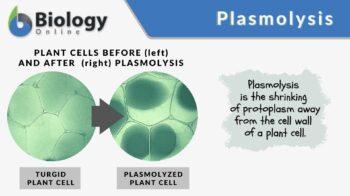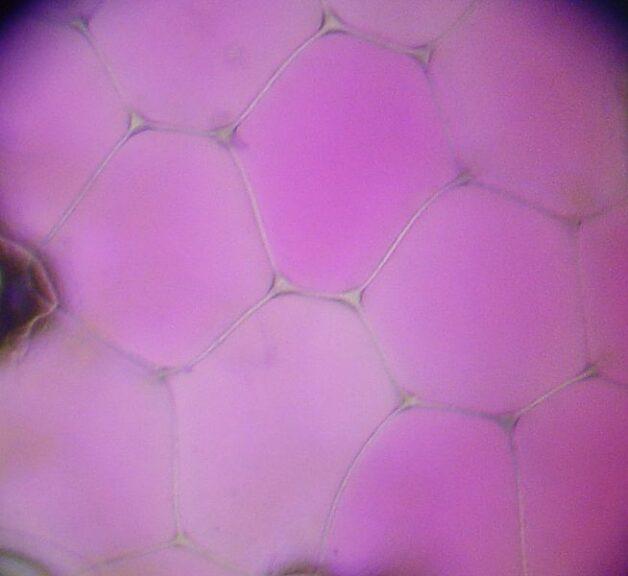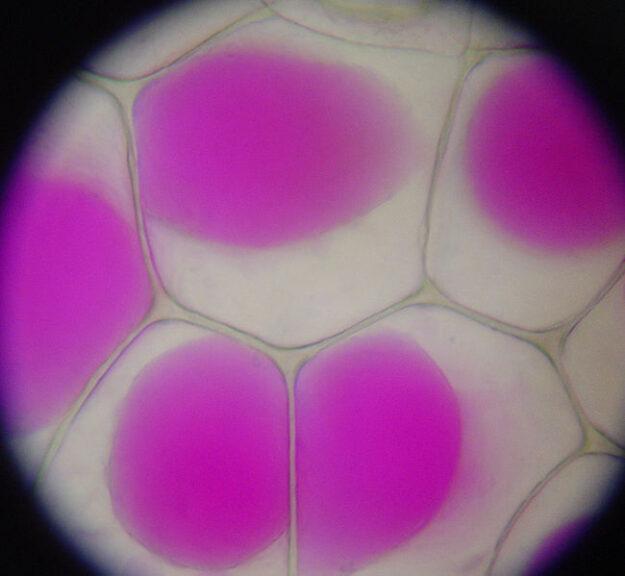
Plasmolysis
n., [plæzˈmɒlɪsɪs)]
Definition: Protoplasm shrinking away from the cell wall of a cell
Table of Contents
Plasmolysis is the shrinking of protoplasm away from the cell wall of a plant or bacterium. The protoplasmic shrinking is often due to water loss via exosmosis, thereby resulting in gaps between the cell wall and the plasma membrane. There are two types of plasmolysis: concave plasmolysis and convex plasmolysis. In concave plasmolysis, the contraction of the protoplasm and the plasma membrane resulted in concave pockets. There are still points of attachment between the cell wall and the protoplasm. Thus, the condition can still be reversed with a hypotonic solution. Convex plasmolysis is a type of plasmolysis that is irreversible. In this case, the plasmolyzed cell is a spherical protoplast that completely detaches from the cell wall.
Plasmolysis Definition
Biology definition:
Plasmolysis is the contraction of the cell due to protoplast shrinking upon exposure to a hypertonic solution. In animal cells, the equivalent condition is termed crenation. Similarly, the plant and the animal cells lose water as water molecules diffuse to their concentration gradient.
Etymology:
The term plasmolysis comes from plasm(a), meaning “matrix” – and lysis, meaning “a loosening”.
In animal cells though, the net efflux of water results in the cells appearing wrinkled. The plant cells, due to the presence of the cell wall, do not appear wrinkled. Rather, they form concave pockets as in the case of concave plasmolysis or they form a full sphere in the case of convex plasmolysis.
|
|
|---|---|
| Plasmolysis is the shrinking of protoplasm away from the cell wall of a cell. Notice that the cell before plasmolysis (top) is turgid. The cell appears swollen. After plasmolysis though (bottom), the cell has gaps between the cell wall and the plasma membrane. Image Credit: Mnolf, CC-3.0. | |
Plasmolysis vs. Cytolysis
Plasmolysis is different from another type of lysis called cytolysis. Cytolysis is the bursting of the cell due to the excessive influx of water. This occurs when the cell is exposed to a hypotonic solution causing the water to diffuse into the cell up to a point when the volume capacity exceeds what the cell membrane can hold. Thus, too much water inside the cell eventuates in cell bursting or cytolysis. This is what happens in red blood cells that eventually burst due to the excessive influx of water. In a plant cell, this does not occur because of the presence of cell wall and turgor pressure.
Both plasmolysis and cytolysis are influenced by osmotic movement due to different osmotic pressures. In cytolysis, water moves into the cell due to the hypotonic surrounding whereas in plasmolysis water leaves the cell due to the hypertonic surrounding. Thus, it seems that cytolysis is the reverse of plasmolysis.
Plasmolysis vs. Turgidity
Both plasmolysis and turgidity are influenced by the osmotic movements of water due to the differing water potential and solute concentrations of the two solutions. In cells, turgidity refers to the swollen state of a cell due to high fluid (water) content. A plant cell, for instance, is normally turgid due to the turgor pressure of the protoplasm. This explains why plants are able to remain rigid and stand upright toward sunlight. Conversely, the plant cell loses water and hence turgor by plasmolysis.
Table 1: Comparison between plasmolysis and turgidity | |
|---|---|
| Plasmolysis | Turgidity |
| Cells lose water by exosmosis (i.e. net water efflux) | Cells gain water by endosmosis (i.e. net water influx) |
| The cell shrinks as the protoplasm and the plasma membrane pull away from the cell wall | The cell swells as the protoplasm and the plasma membrane press against the cell wall |
| Occurs when the cell is in a hypertonic solution | Occurs when the cell is in a hypotonic solution |
| Turgor pressure drops | Turgor pressure rises |
| Results in the wilting of plants | Results in plant rigidity and being upright of plants |
Data by: Maria Victoria Gonzaga of Biology Online
Plasmolysis vs. Flaccidity
In a strict definition, plasmolysis is the shrinking of the protoplasm due to exposure to the hypertonic surrounding. Flaccidity is the loss of turgor due to the lack of net water movement between the plant cell and the isotonic surrounding. Flaccidity, however, is similar to plasmolysis in terms of losing cell turgor and resulting in the wilting of the plant. Also, both of these conditions can be restored to the normal plant cell turgor state by turning the solution surrounding the cell hypotonic. Nevertheless, a flaccid cell is one in which it is neither turgid (swollen) nor plasmolyzed (shrunk).
Process of plasmolysis
One of the functions of a plant vacuole is osmoregulation. Through it, the plant cell is able to regulate and maintain proper solute concentration and idyllic osmotic pressure inside the cell. Water tends to diffuse passively across the plasma membrane. This means that water moves into or out of the cell depending on differences in water potential or in solute concentrations. Osmosis refers to the net passive movement of water from an area of high water potential to an area of low water potential.
In terms of solute concentration, water molecules move towards the area of the solution containing more solutes. Regulating water and solute levels inside the cell is essential to maintain turgor pressure. This pressure generated by water molecules pressing against the cell wall of the plant cell is crucial to the vitality of the plant structure. A turgid plant cell prevents the cell from taking in water any further. However, if turgor pressure is lost, the plant cells will lose their vigor and thus appear wilted. This occurs when a plant cell is exposed to an isotonic surrounding. This means that the solute concentrations between the cell and its surroundings are the same. This results in incipient plasmolysis, which means the cell is no longer turgid and about to become plasmolyzed. A cell that has lost its turgor is said to be flaccid.
A solution that has more solutes than another solution is described as hypertonic. For example, a hypertonic extracellular fluid means that it has more solutes than the plant cell contents. In this case, water in a hypertonic solution would not be able to generate a net movement favoring the cell. Rather, the net movement of water will result in the plant cells losing water. This is a case of plasmolysis. The cell where water diffuses out of the cells leading to the loss of turgor pressure is said to have plasmolyzed. The protoplasm appears to have shrunk from the cell wall. This condition though is reversible and can be corrected by deplasmolysis. If not, further loss of water will eventually lead to cytorrhysis, i.e. the complete collapse of the cell wall. Cytorrhysis is irreversible and leads to the death of the plant cell. Plasmolysis, though, only occurs in extreme conditions. It rarely happens in nature. It is induced in plasmolysis experiments in the laboratory by immersing cells in strong saline or sugar solutions to cause exosmosis.
Concave vs. Convex Plasmolyses

Plasmolysis is the process resulting in the net efflux of water molecules via osmosis. A cell that has undergone plasmolysis is characterized by the shrinking of protoplasm. Thus, an indication that plasmolysis occurs is the gap forming between the cell wall and the plasma membrane. There are two major types of plasmolysis based on the appearance of protoplasmic shrinking: concave plasmolysis and convex plasmolysis. In concave plasmolysis, the protoplasm shrinks inwardly with respect to the cell wall. While plasmolysis is reversible in concave-type, it is irreversible in convex-type. Concave plasmolysis may be reversed by deplasmolysis. That is by making the surrounding solution hypotonic to the plasmolyzed cell. In nature, the plant prevents further water loss by regulating stomata and producing water-resistant wax.
Examples
Plasmolysis is a rare occurrence in nature. It is mostly induced in the laboratory, e.g. by immersing plant cells in solutions that are high in salt or sugar. In nature, it occurs when the plant is exposed to increased salinity (e.g. coastal flooding) or when exposed to chemicals (e.g. weedicides).
Importance
Plasmolysis is a response of the plant cell against a hypertonic surrounding as mentioned above. It results from the detachment of the protoplasm against the cell wall. When this occurs, the space between the cell wall and the protoplasm becomes filled with solutes. Consequently, water diffuses to this area. The partial detachment of the protoplasm from the cell wall indicates that the plant needs to rectify the condition and thus incites the plant to take in water from the roots and prevent further water loss via the stomatal mechanism. Thus, this could be construed as an advantage of plasmolysis as long as cytorrhysis is not reached. Otherwise, the excessive plasmolysis could end up in the irreversible loss of structural integrity, and eventually the death of the cell.
Try to answer the quiz below to check what you have learned so far about plasmolysis.
See also
References
- Lang, I. (2014). Plasmolysis: Loss of Turgor and Beyond – NCBI. Retrieved from https://www.ncbi.nlm.nih.gov/pmc/articles/PMC4844282/.
- Turgid vs plasmolyzed. (n.d.). Retrieved from https://www.ncbi.nlm.nih.gov/pmc/articles/PMC4844282/
- Kowles, R. V. (n.d.).Regulation of Water in Plant Cells. Retrieved from https://files.eric.ed.gov/fulltext/EJ889710.pdf
- Plasmolysis of Elodea. (n.d.) Retrieved from CSUN.edu. Retrieved from http://www.csun.edu/scied/7-microscopy/elodea_plasmolysis/index.htm
- Williams, J. I. (n.d.). Plasmolysis. Retrieved from http://faculty.southwest.tn.edu/jiwilliams/plasmolysis.htm
© Biology Online. Content provided and moderated by Biology Online Editors




